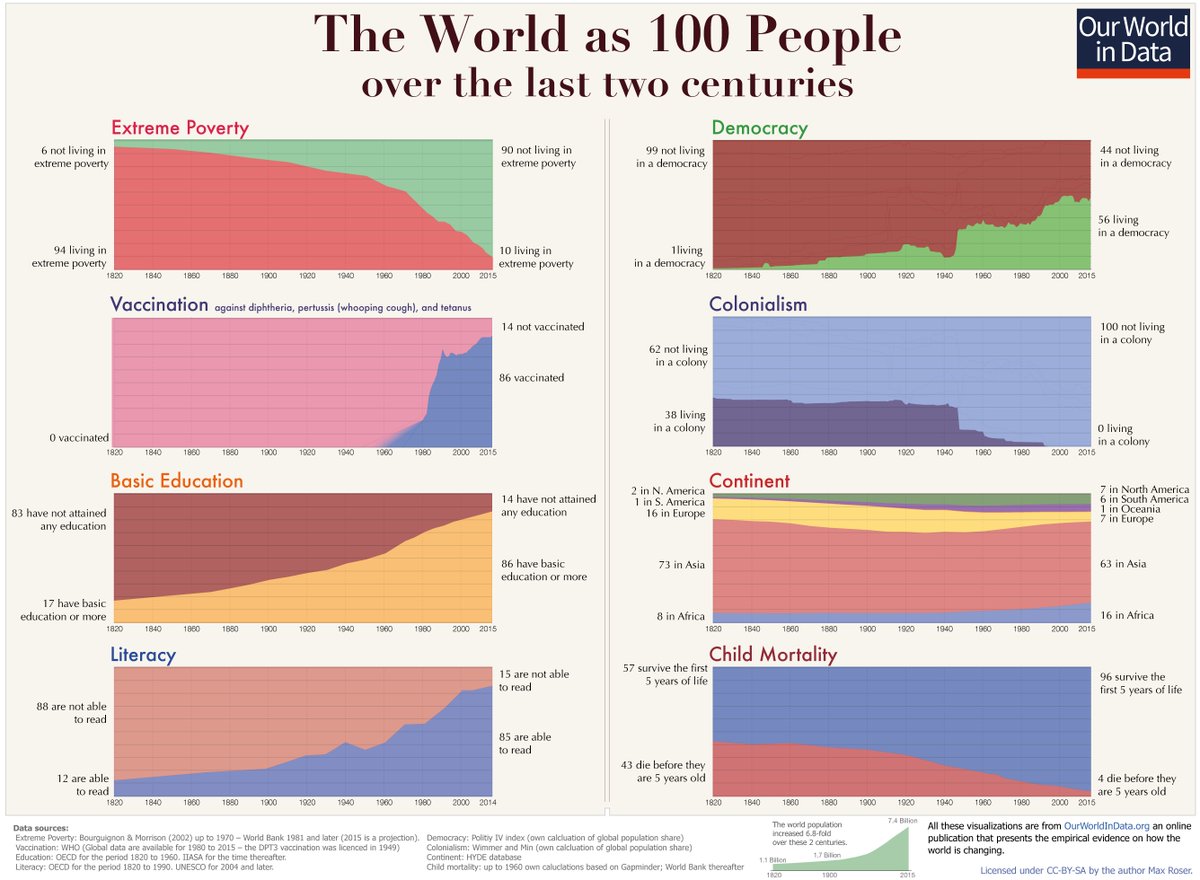The same patterns appears everywhere. The language is different - it's also within the language.
These similarities reveals the correlation - as symmetries; laws/formulas/algorithms.
These symmetries reveal the not-yet-discovered-things-and-properties.
Simplicity enables Maximum events (Information) per Time or Energy,
and this efficiency emerge (self-organising).
Events that hasn't happened is a sort of potential energy. Or Entropy is the weight past events.
Dark matter: of course waves (electrons/gravitons/photons/...) needs a inter-medium.
----
What is the shape of all knowledge ?
As xkcd and others have suggested, if you repeatedly follow the first link presented in an article, you’ll always end up at Philosophy.
We found that articles consistently flow from specific to broader topics—similar to the banana’s path from fruit to biology, with most paths converging on a few topics. When we measured accumulation and influence, the dominant articles fit in one of three categories: academic disciplines (left hand), abstract notions (middle hand), and modern topics (right hand).
SCIENTIFIC CONCEPTS GENERALCONCEPTS HUMAN CONCEPTS

You’ll find a handful of articles floating in a word cloud. Philosophy, as suspected, is especially dominant, ranking first in influence by two orders of magnitude. After Philosophy come broad areas of knowledge: biology, health care, and “web page”.
Copied from: Site ----
WomensMarch
On January 21st, 2017, the Women’s March on Washington gathered enormous crowds in collective protest of the newly inaugurated President of the United States, Donald Trump.

---
Chart types: FT
https://github.com/ft-interactive/chart-doctor/blob/master/visual-vocabulary/Visual-vocabulary.pdf
-----
Sleep - twitter

----
Traveling pattern

---
IMPROVEMENTS
Division of tasks + Efficient cooperation (between tasks) --> Most Effective output
Cooperation requires trust

Democracy Index

---
DATA VISUALISATION CATALOGUE

-----
VISUALISATION TOOLS

Comparing these tools:

Twitter: https://twitter.com/lisacrost
---

----
Act & React


----

http://www.futuretimeline.net/blog/2017/02/14.htm#.WKOZ0fkrKwU
-----
Proverb/Adage
Balance Of Power : The Equal Stake Model : "Fortune for Unfortunate."
"Power Corrupts, and Absolute Power Corrupts Absolutely"
"Freedom consists of the Distribution of Power, and Despotism in it's Concentration"
Link
----
Neural Network v.s. Deep Learning

Link: https://t.co/f3t5ntFJve (via: https://twitter.com/hashtag/NeuralNetworks?src=hash)
Neural networks (NNs), recently referred to as deep learning, only work "effectively" with data that is produced from a process of a continuous function.
1. Classify - give it a name
2. Cluster - group-name

----
Criminal faces (10% fail-rate?)

Read the black-board

--
Nice (R-code)

---
Visual Information Theory
"Machine learning is what I know best, so let’s talk about that for a minute. A very common kind of task in machine learning is classification. Let’s say we want to look at a picture and predict whether it’s a picture of a dog or a cat. Our model might say something like “there’s a 80% chance this image is a dog, and a 20% chance it’s a cat.” Let’s say the correct answer is dog – how good or bad is it that we only said there was an 80% chance it was a dog? How much better would it have been to say 85%?
This is an important question because we need some notion of how good or bad our model is, in order to optimize it to do well. What should we optimize? The correct answer really depends on what we’re using the model for: Do we only care about whether the top guess was right, or do we care about how confident we are in the correct answer? How bad is it to be confidently wrong? There isn’t one right answer to this. And often it isn’t possible to know the right answer, because we don’t know how the model will be used in a precise enough way to formalize what we ultimately care about. The result is that there are situations where cross-entropy really is precisely what we care about, but that isn’t always the case. Much more often we don’t know exactly what we care about and cross-entropy is a really nice proxy.12
Information gives us a powerful new framework for thinking about the world. Sometimes it perfectly fits the problem at hand; other times it’s not an exact fit, but still extremely useful. This essay has only scratched the surface of information theory – there are major topics, like error-correcting codes, that we haven’t touched at all – but I hope I’ve shown that information theory is a beautiful subject that doesn’t need to be intimidating."
Link: http://colah.github.io/
-------
Organic Style of Generative Design
"The Dreamcatcher system allows designers to input specific design objectives, including functional requirements, material type, manufacturing method, performance criteria, and cost restrictions."
--> Revenue/Cost side: Target/Restrictions
The inside of AI-brain:

Functions blocks
Not surprising despite being different from biology, the resulting observable behaviour is similar. It confirms that the fundamental processes underlying all are the same. I'm happy to truly understood the fundamental processes that everyone is seeking to discover.

Survival = Time
-----

I have most of them
----

----
-----

I have most of them
----

----
NEURAL NETWORK CAN CREATE HIGH-RES IMAGES BASED ON A TEXT DESCRIPTION
“For many years, we have trained neural networks to perform tasks like face, traffic sign, or handwriting recognition,” Zsolnai-Fehér told us. “Generally, with millions of training examples, we show the neural network how to do something, and expect them to learn these concepts, and do well on their own afterwards. This piece of work is completely different: here, after learning the neural networks are able to create something completely new — such as synthesizing new, photorealistic images from a piece of text we have written. This opens up a world of possibilities, and I am super-excited to see where researchers take this concept in the future.”
----
Shockingly high numbers
Most people are would never believe that 50%,
of all New Yorkers are in poverty for at least One year.
Fathom Information Design, in Boston, MA
----
And salaries?

----
https://youtu.be/dVh3pzyjnUU?t=1240 20:40
---

Growth in Sales and Income (salaries)
----
Sell your personal data

-----
Lessons to young scientists
https://www.ted.com/talks/e_o_wilson_advice_to_young_scientists#t-382206
---
R
R-apps: http://www.computerworld.com/article/2921176/business-intelligence/great-r-packages-for-data-import-wrangling-visualization.html




